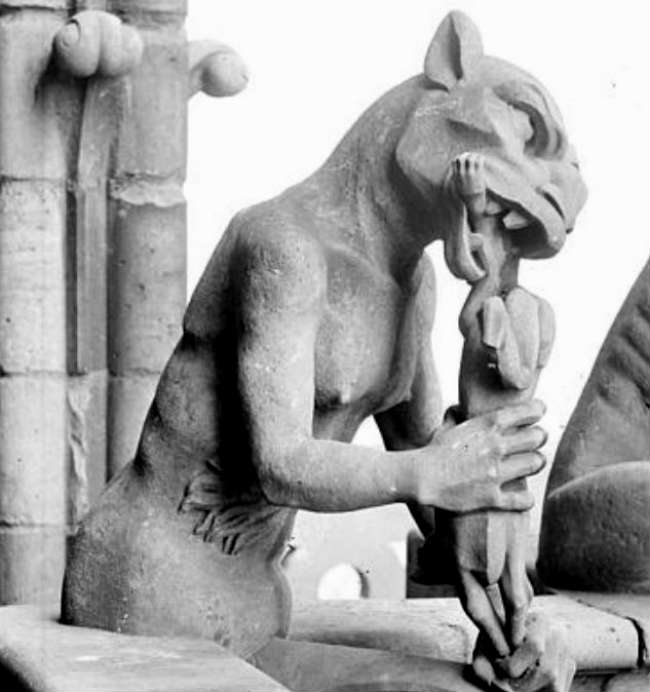Cat-human Hybrids
Mammalian Hybrids
|
The goddess Bast is usually represented in the form of a woman with the head of a cat.
—Sir Wallis Budge,
The Gods of the Egyptians |
 Georg Friedrich von Jäger
Georg Friedrich von Jäger Over the years there have been numerous reports about cat-human hybrids, some in medical journals, others in the news. One detailed report was authored by Georg Friedrich von Jäger (1785-1866), a German physician and naturalist with a special interest in developmental abnormalities. In his paper (Jäger 1830), he describes the results of an autopsy he conducted on a child who had died soon after birth. It was a fully developed male child birthed by a human mother, he says (p. 112), but whose head bore a "close resemblance" ("grosse Aehnlichkeit") to that of a cat. This strange mix was supposedly born in Wüstenrot, Germany in December 1829.†
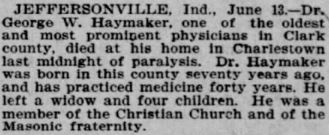 An obituary of Dr. G. W. Haymaker (Indianapolis Journal, Jun. 14, 1900, p. 2). A longer obituary >>
An obituary of Dr. G. W. Haymaker (Indianapolis Journal, Jun. 14, 1900, p. 2). A longer obituary >>
Owen, Indiana. Next, an American case, in which a well-respected physician, Dr. George W. Haymaker of Charlestown, Indiana (see his obituary at right), claimed to have delivered a child with the head of a cat. The news notice quoted here appeared in the Indianapolis News (Oct. 22, 1889, p. 1, col. 3):
Monstrosity at Birth
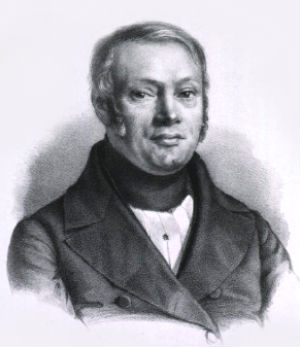 Friedrich Peter Ludwig Cerutti
Friedrich Peter Ludwig Cerutti Skeleton of the specimen described by Cerutti (1827). Note similarity to the ancient statuette of the Egyptian goddess Bast pictured below.
Skeleton of the specimen described by Cerutti (1827). Note similarity to the ancient statuette of the Egyptian goddess Bast pictured below.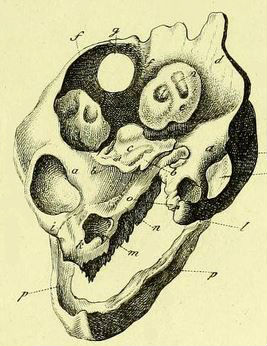 The skull of Cerutti’s specimen
The skull of Cerutti’s specimen
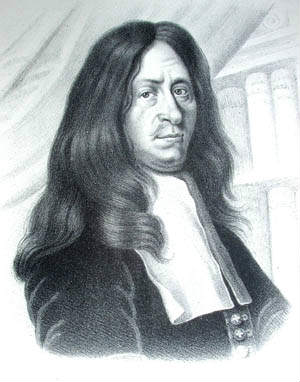 Thomas Bartholin
Thomas Bartholin
Budapest, Austria-Hungary. The following brief notice appeared in the Viennese newspaper Welt Blatt (Aug. 26, 1875, p. 9, col. 2):
Leipzig, Germany. A cat-headed child in the anatomical collection of the University of Leipzig was described in detail by Friedrich Peter Ludwig Cerutti (1789-1858), extraordinary Professor of Pathological Anatomy (außerordentlichen Professor der Pathologischen Anatomie) at that university (Cerutti 1827). The postcranial skeleton was, in general, like that of an ordinary human. The cranium was open above and anencephalic* (see Cerutti’s illustrations at right). The face of this female specimen, which was birthed by a woman, bore fur that extended down as far as the neck.‡ Elsewhere, says Cerutti, the skin was like that of a human. In German such births are, according to Cerutti (p. 10), generally referred to as Katzenköpfe (i.e., "cat heads").
‡ See Cerutti (1827, p. 10). Original Latin: “cutis pilis teneris obsessa tegit, quae in cerivicem latum terminatur.”
Buxtehude, Germany. The German physician Johann Ludwig Hannemann (Acta Medica et Philosophica Hafniensia, 1676, vol. 4, part 1, observation xi), a professor of medicine at the University of Kiel, reported that a young woman at Buxtehude had given birth, from the same pregnancy, not only to a normal child, but also to a stillborn fetus with the head of a lion.§
Antwerp, Belgium. The German physician Salomon Reisel (1683, p. 274), too, describes a “child” born at Antwerp on September 17, 1682 “whose head and shoulders had skin, fur and whiskers like those of a cat, while the other parts of the body were like a human.”**
Leiden, Holland. In his Historiarum Anatomicarum Rariorum (Hafniae, 1654, Centuria II, p. 241), the Danish physician Thomas Bartholin (1616-1680), who is now primarily remembered for his discovery of the lymphatic system, recorded the birth of yet another “child” of the same sort. He states that, in Holland,
Basel, Switzerland. And in his chronicle of prodigies (Prodigiorum ac ostentorum chronicon 1665, p. 241) the Renaissance author Conrad Lycosthenes listed another, possibly cat-headed birth. A resident of Basel, Switzerland, he says that a child “with a hairy head like that of a dog, or indeed, more like that of a cat or monkey” was born in that city in 1556. So perhaps Lycosthenes, who died in Basel in 1561, saw this tertium quid with his own eyes?
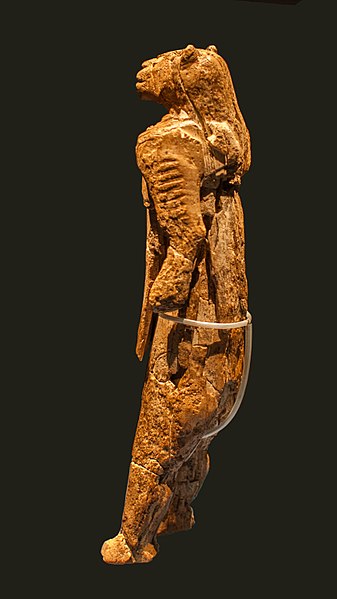 The Löwenmensch (“lion-man”), a lion-headed figurine with a human-like body found at Stadel Cave, Baden-Württemberg, Germany, in 1939. Carved out of mammoth ivory, it is the oldest-known animal-shaped sculpture in the world. Carbon dating shows it was created between 35,000 and 40,000 years ago. Image: Thilo Parg / Wikimedia Commons (License: CC BY-SA 3.0)
The Löwenmensch (“lion-man”), a lion-headed figurine with a human-like body found at Stadel Cave, Baden-Württemberg, Germany, in 1939. Carved out of mammoth ivory, it is the oldest-known animal-shaped sculpture in the world. Carbon dating shows it was created between 35,000 and 40,000 years ago. Image: Thilo Parg / Wikimedia Commons (License: CC BY-SA 3.0)
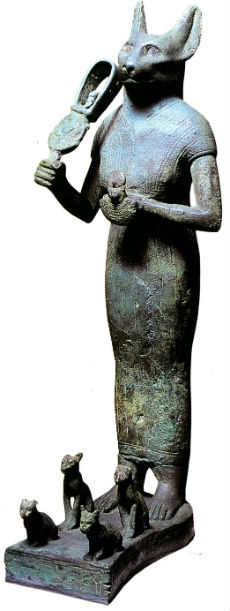 The cat-headed goddess Bast. The Egyptians held annual festivals in honor of Bast in her sacred city of Bubastis.
The cat-headed goddess Bast. The Egyptians held annual festivals in honor of Bast in her sacred city of Bubastis.
Has history become myth?
Remarkably, all of the reports cited thus far—with the possible exception of the birth at Basel—describe creatures that would have looked much like the Egyptian cat-headed goddess Bast. (Obviously, Cerutti’s specimen, the skeleton of which is shown at right above, would have looked like an anencephalic Bast.) In The Lord of the Rings, Galadriel says,
Is it possible that the Egyptians, with their stable civilization that lasted more than three millennia, with their long recorded history, might have remembered things that have now been lost? that for us have "passed out of all knowledge"? Might not modern science, which has existed for only about four hundred years, now call some of those formerly remembered realities myth?
It seems the people of the Nile were careful record keepers and more informed than other nations concerning what had happened in times gone by. The Greek historian Herodotus (2.77.1), who travelled over much of the known world, including Egypt, to question people about the past, commented that
Liceti’s cat
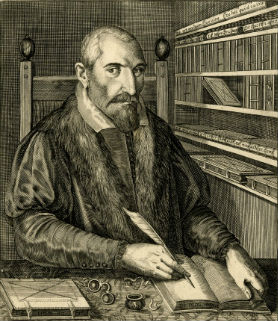 Fortunio Liceti
Fortunio Liceti
Fortunio Liceti (1577-1657) was an Italian physician and scientist who spent most of his long career as a professor of medicine at the University of Padua. He was friends with Galileo and the author of a veritable flotilla of scholarly books, most of which fall within the fields of medicine and natural philosophy. His special interests included the topics of generation, development and teratology Landauer (1961, p. 156) says Liceti "expressed the belief that the gestation period of women is sufficiently variable
Perhaps Liceti’s most famous production is De monstrorum caussis, natura et differentiis (On monsters: Their origins, nature and variety), a remarkable tome that attempted to assemble all reports of abnormal human development. In it, Liceti (1634, pp. 193-194) reports and pictures (see image below) an ostensible cat-human hybrid, which, if real, would represent an extreme rarity—a cat-human hybrid conjoined twin in which the human portion was parasitic.
Liceti was living in Padua at the time of the alleged event. Therefore, if it did in fact take place, he could potentially have been an eyewitness. An English translation of his report reads,
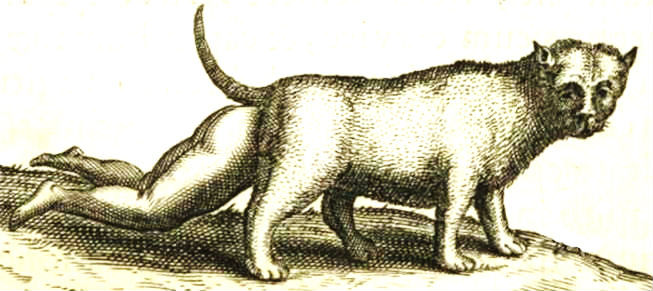 An ostensible cat-human hybrid, which would also represent a case of unequal conjoined twins (pictured in Liceti 1634). Enlarge
An ostensible cat-human hybrid, which would also represent a case of unequal conjoined twins (pictured in Liceti 1634). Enlarge
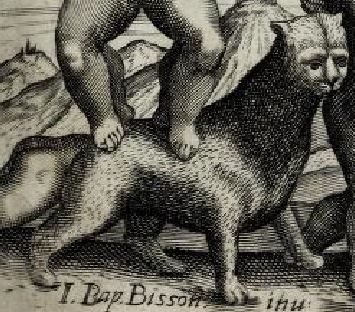 A second picture of the Padua cat-human appears in the lower lefthand corner of the frontispiece of Liceti’s De Monstris. The parasitic human rump and legs can be seen at left.
A second picture of the Padua cat-human appears in the lower lefthand corner of the frontispiece of Liceti’s De Monstris. The parasitic human rump and legs can be seen at left.
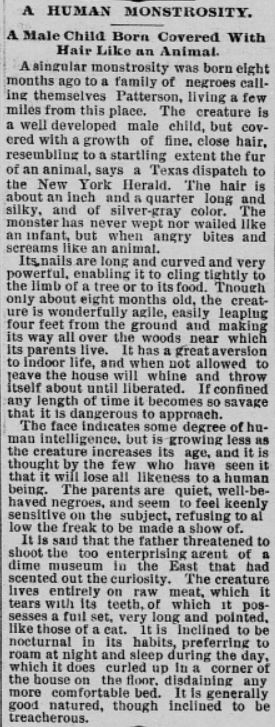 News report describing a living, viable cat-human hybrid. Source: St. Paul Daily Globe (Jan. 22, 1892, p. 5, col. 5 ).
News report describing a living, viable cat-human hybrid. Source: St. Paul Daily Globe (Jan. 22, 1892, p. 5, col. 5 ).
A cat with hands? Another report appeared in a Michigan newspaper, the Crawford Avalanche (Aug. 21, 1890, p. 3, col. 3). In it, a cat is described as having human hands. This birth supposedly happened at Rust Township in the northeastern part of Lower Michigan. The relevant passage reads as follows:
Obviously, it is highly unlikely that a mutant cat without human ancestry might suddenly develop human hands. So this report either refers to a cat-human hybrid or was simply a hoax. If it was a truthful report, then the animal described may (or may not) have been the same one mentioned the following year in The Helena Independent (June 24, 1891, p. 2) as “a cat with a human hand,” appearing in a Boston cat show.
A related news report, which appears on another page of this website, describes an extremely bizarre human-cat-chicken three-way hybrid birthed by a woman in Missouri.
About the Missouri case >>
Appendices
The Temple of Bast. Though Bubastis, the sacred city of Bast, is today a mere pile of rubble, Herodotus (2.137-138) described the Temple of Bast there as the most lovely of all the temples he saw in Egypt:
Women birthing cats? A few old reports exist about women giving birth to cats. Christian Franz Paullini (1686) communicated an abridgement of a manuscript compilation of curiosities collected by the monks Isibordus von Amelunxen and Alexander Insulanus at the Imperial Abbey of Corvey around 1200 A.D. Observation III (Paullini 1686, p. 186) of that compilation states that in the year 874, according "the monk Geroldus," a woman on his estate had given birth to a cat and, as a result, been burned at the stake (see also: Isensee 1843, p. 287). And Foresti claimed a woman at Pavia gave birth to a cat in 1471 (Supplementum chronicorum, Paris, 1535, p. 382). This "muliere Papiensi" was also mentioned by Liceti (De monstrorum, 1634, p. 216). But these accounts, though made by serious, educated people, are so early and vague as to really amount to little more than myth.
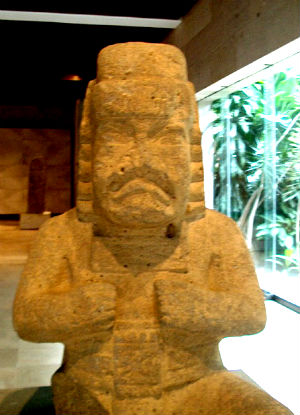 Olmec werejaguar
Olmec werejaguar
Werejaguars. In Olmec culture, werejaguars were half-man, half-jaguar supernatural entities. American archaeologist Matthew Stirling (1955) set forward what has since become known as the Stirling Hypothesis, which proposes that werejaguars were produced from a hybridization between a jaguar and a woman.
A human-marten hybrid? Alfons Khon (1678, p. 74, Observation XXIII), a professor at the University of Jena, reported a woman giving birth to a stillborn anencephalic male offspring with marten-like characteristics. In particular, he said, it had a tail like that of a marten. Khon explained this birth by the fact that the pregnant mother had been frightened by a marten. Martens have been reported to hybridize with cats, and the Latin word feles means both marten and cat. However, the word actually used in Khon’s Latin language report was martes, which means marten, and not cat.
A list of cat crosses
The following is a list of reported cat crosses. Some of these crosses are much better documented than others (as indicated by the reliability arrow). Indeed, some might seem completely impossible. But all have been reported at least once. The links below are to separate articles. Additional crosses, not listed here, are covered on the cat hybrids page.
|
|
By the same author: Handbook of Avian Hybrids of the World, Oxford University Press (2006).
Most shared on Macroevolution.net:
Human Origins: Are we hybrids?
On the Origins of New Forms of Life
Mammalian Hybrids
Cat-rabbit Hybrids: Fact or fiction?
Famous Biologists
Dog-cow Hybrids
Georges Cuvier: A Biography
Prothero: A Rebuttal
Branches of Biology
Dog-fox Hybrids
